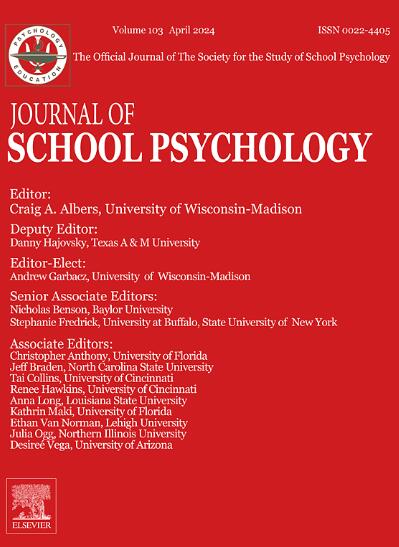Universal Teacher-Child Interaction Training in early childhood special education: Identifying mechanisms of action that explain why it works
IF 4.1
1区 心理学
Q1 PSYCHOLOGY, SOCIAL
引用次数: 0
Abstract
Teacher-Child Interaction Training-Universal (TCIT-U) is effective for increasing teachers' use of strategies that promote positive child behavior; however, the exact mechanisms of change are unknown. Using a cluster randomized control trial in a sample of 410 racially- and ethnically-diverse children (Mage = 41.73 months; 50% White, 45% Black/African-American, 4% Multiracial, 1% Asian; 59% Hispanic; 87% with disabilities) taught by 102 teachers from 38 classrooms in eight schools, we attempted to identify these mechanisms of action. Results identified two mechanisms of action by which TCIT-U worked to benefit children in this sample. Enrollment in TCIT-U helped teachers learn to provide labeled praise for child behaviors (as measured by observer ratings) and appropriately follow through on commands (as measured by observer ratings) they issued, which subsequently caused children to experience better socioemotional functioning (as measured by on the teacher-reported Devereux Early Childhood Assessment) and fewer externalizing problems (as measured by the Sutter-Eyberg Student Behavior Inventory – Revised). Specifically, being in the TCIT-U intervention predicted more teacher use of labeled praise at post-treatment, which predicted lower child SESBI-Intensity scores at 1-month follow-up (Indirect Effect B = −1.97, SE = 0.73, p < .01). Additionally, being in the TCIT-U intervention predicted teacher follow-up on a greater proportion of direct commands post-treatment, which was associated with fewer student externalizing problem behaviors post-treatment (Indirect Effect B = −1.47, SE = 0.70, p = .04) and with higher student DECA Total Protective Factor scale scores post-treatment (Indirect Effect B = 3.72, SE = 1.63, p = .02). We discuss reasons why changing these two teacher behaviors might serve as mechanisms of change in our sample. Current findings reveal why TCIT-U might be effective as a universal prevention program that promotes socioemotional functioning and reduces externalizing behavior in racially- and ethnically-diverse samples of children with disabilities.
幼儿特殊教育中的师幼互动通用培训:确定解释其为何有效的作用机制
教师与儿童互动通用培训(TCIT-U)能有效提高教师对促进儿童积极行为的策略的使用;然而,变化的确切机制尚不清楚。我们对来自 8 所学校 38 个班级的 102 名教师所教的 410 名不同种族和民族的儿童(年龄 = 41.73 个月;50% 白人、45% 黑人/非裔美国人、4% 多种族、1% 亚洲人;59% 西班牙裔;87% 残疾儿童)进行了分组随机对照试验,试图找出这些作用机制。结果表明,TCIT-U 有两种作用机制使样本中的儿童受益。参加 TCIT-U 有助于教师学会对儿童的行为进行有标签的表扬(以观察者的评分为准),并适当地落实他们发出的指令(以观察者的评分为准),从而使儿童的社会情感功能得到改善(以教师报告的德弗里幼儿评估为准),外化问题减少(以萨特-艾伯格学生行为量表-修订版为准)。具体来说,参加 TCIT-U 干预预示着教师在治疗后会更多地使用标记表扬,这预示着儿童在 1 个月随访时的 SESBI-Intensity 分数会更低(间接效应 B = -1.97, SE = 0.73, p <.01)。此外,参加 TCIT-U 干预项目还预示着教师在治疗后会跟进更多的直接命令,这与治疗后学生外化问题行为的减少有关(间接效应 B = -1.47, SE = 0.70, p = .04),也与治疗后学生 DECA 总保护因子量表得分的提高有关(间接效应 B = 3.72, SE = 1.63, p = .02)。我们将讨论在我们的样本中,改变这两种教师行为可能成为改变机制的原因。目前的研究结果揭示了为什么 TCIT-U 可以有效地作为一项通用预防计划,在不同种族和民族的残疾儿童样本中促进社会情感功能并减少外化行为。
本文章由计算机程序翻译,如有差异,请以英文原文为准。
求助全文
约1分钟内获得全文
求助全文
来源期刊

Journal of School Psychology
PSYCHOLOGY, EDUCATIONAL-
CiteScore
6.70
自引率
8.00%
发文量
71
期刊介绍:
The Journal of School Psychology publishes original empirical articles and critical reviews of the literature on research and practices relevant to psychological and behavioral processes in school settings. JSP presents research on intervention mechanisms and approaches; schooling effects on the development of social, cognitive, mental-health, and achievement-related outcomes; assessment; and consultation. Submissions from a variety of disciplines are encouraged. All manuscripts are read by the Editor and one or more editorial consultants with the intent of providing appropriate and constructive written reviews.
 求助内容:
求助内容: 应助结果提醒方式:
应助结果提醒方式:


